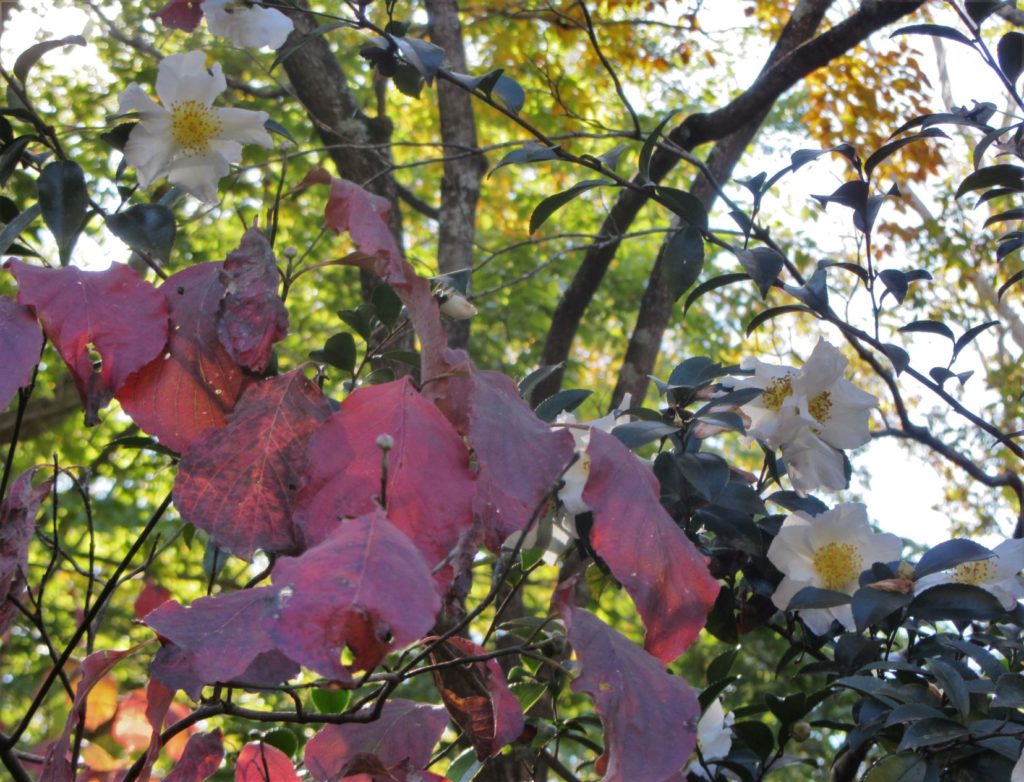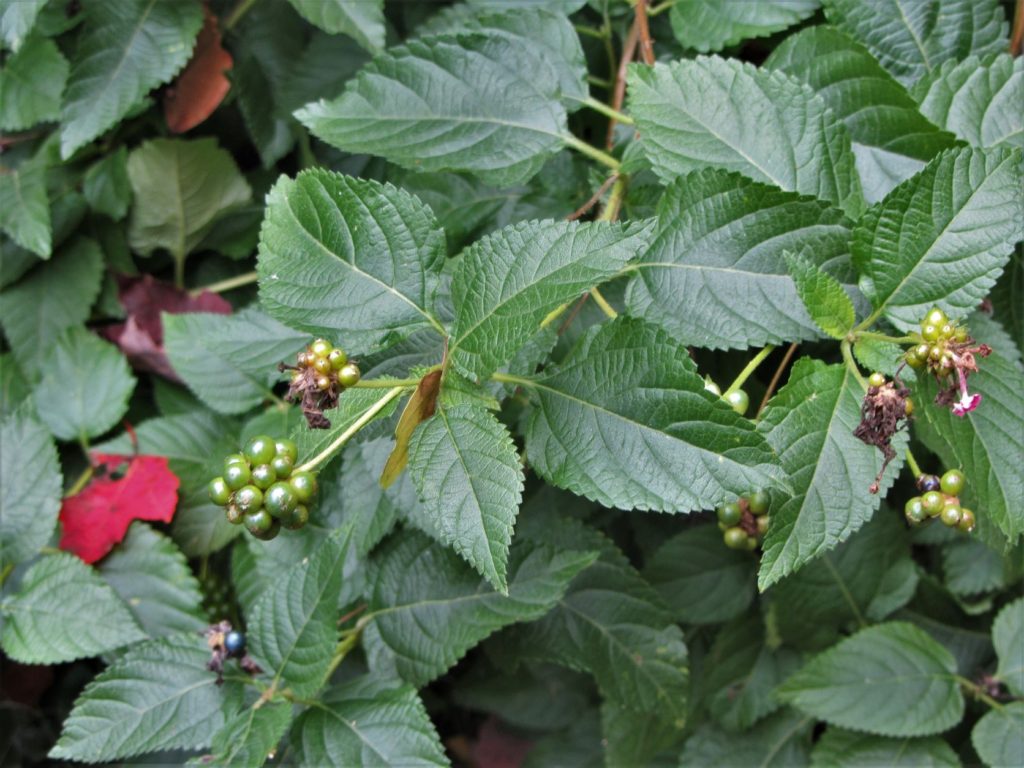Working With Nature to Put the Garden to Bed

Camellia sasanqua blooms as autumn leaves begin to fall. Many trees and shrubs have already set their buds for spring flowers.
“Leave it be.” Words I heard with some frequency growing up….
This simple bit of advice may be just the wisdom we need whether baking, navigating relationships, or preparing the garden for winter. “Leave it be” insists that we quiet our urge to interfere with natural processes. It asks us to step back and observe; to allow for a solution to unfold on its own.
Some gardeners feel compelled to tidy up the leaves and sticks as they fall, to cut back perennials as they fade, to pull out the annuals before they freeze, and to prune back shrubby trees as soon as possible.
While some neighbors and neighborhoods might expect this level of neatness, it isn’t nature’s way. Letting our gardens take their time to die back and settle into winter allows nature to recycle and re-purpose materials in interesting ways. It isn’t so much that you avoid fall clean up chores; you strategically tweak the timing of when to do them.
Here are some things you might choose to “Leave be” for a while longer:
Seed heads provide important food for birds and other wild things. Hibiscus, Rudbeckia, basil and Echinacea seeds attract goldfinches and other birds. None of those seeds will be wasted when left in the garden.
Don’t cut seed-bearing perennial stems until they have been picked clean. Make an exception for any self-seeders that you don’t want to spread further. Cut them as soon as the flowers fade. When you do finally clear up the remains of faded annuals and perennials, compost them or stack them in a brush pile where they can decompose, enriching the soil. Beneficial insects will overwinter in those perennial stems.

Echinacea seeds satisfy many birds as food grows scarce. More coneflower plants are always welcome, if it reseeds.
While some varieties of Lantana are too tender to survive our winters, others, particularly L. ‘Miss Huff’ and related cultivars, will return with a bit of help. Lantana is a perennial shrub in its native range. Left alone at the end of the summer, Lantana regularly survives winter in our garden.

Leave Lantana standing until early spring. Birds shelter in their woody stems and eat remaining seeds.
Birds continue to eat their seeds and find shelter in the plants through the winter. Cutting back woody Lantana branches too early allows cold to penetrate to the roots, potentially killing the plant. Wait until March to cut back Lantana and watch for new growth by early May.
Leave pruning chores until after the first of the year. Allow trees and shrubs to go fully dormant before removing wood. I prefer to leave pruning until February.
Trees and shrubs will potentially suffer more winter dieback when pruned too early, because pruning stimulates growth. Roses, and other flowering shrubs pruned hard in fall, will likely start growing again too soon. The new, tender growth may freeze.
Wait to prune spring flowering shrubs, like Azaleas, Rhododendrons, Pieris, Camellias, Japanese Quince and Forsythia until late spring, after they bloom. Their flower buds are already set by autumn, and any pruning done now will reduce next spring’s flowers.
Fallen leaves and pine tags serve many useful purposes. Chopped or shredded leaves offer one of the best amendments to improve the soil as they fulfil their natural purpose as mulch around woody plants.
As they decompose, they add carbon, nitrogen and many other nutrients the tree stored in the leaf all summer back into the soil, as they also improve soil texture. Leaf mulch attracts earthworms that will enrich and loosen the soil wherever they burrow. This helps nearby plants absorb water and nutrients more efficiently.
Leaf mulch also encourages the growth of mycelium. You might have noticed white threadlike structures growing in soil, or under a pile of leaves. These threads of mycelium are a good sign of healthy soil. Mycelium, which is the permanent, underground part of a mushroom or fungus, helps to decompose organic matter in the soil, freeing up the nutrients for use by plants. Mycelium also helps to transport sugars and elements from the roots of one plant to another.
Only rake fallen leaves enough to make them accessible for the lawn mower or leaf vacuum. Once shredded, spread them wherever there is a need for some winter insulation, to conserve moisture or to improve the soil. Mow fallen leaves on the lawn, chopping them finely enough to leave in place to feed your lawn.
How often have you seen folks rake and bag their leaves or pine tags for collection, and then purchase bags of fertilizer and mulch? Leaves are a tremendous natural resource we can recycle at home.
Pine tags help nourish shrubs such as Azaleas, Hydrangeas and Camellias that prefer acidic soil. Even fallen twigs and branches can help improve the soil. Chip them up into smaller pieces and pile them in out of the way places or use them as the base for new raised beds. Wildlife will use them for shelter, or to search for food, as they decompose.
“Leaving the soil be” is one of the smartest things a gardener can do. Pile on the organic matter but resist the urge to dig and turn the soil. Plants grow best in soil which supports a vibrant ecosystem of microbes and invertebrates. Our gardens depend on a rich web of relationships between roots, bacteria, fungus, insects, worms, and decaying organic matter in the soil for their vitality. Digging and tilling disturbs this complex underground ecosystem.
Even as we leave the summer’s remains to rest awhile before cleaning them up, there is still plenty to do in the garden. Here are a few timely tasks for autumn days when you want to work outside:
- Cut the grass a final time as the leaves are falling. The green grass clippings mix nicely with the brown leaves to speed along composting. You can catch the trimmings in a bag or leave this rich mixture in place to feed the soil.
- Take cuttings of favorite plants that will root easily in water. Change the water every few weeks as you watch the progress of root growth on the stems. You can plant the rooted cuttings into pots of soil indoors and hold them for spring.
- Clean up pots of tender perennials to bring indoors for the winter. Many plants we discard as ‘annuals’ can be kept year to year in a frost-free area, even with low light and little water. Tuberous tender perennials keep well with a minimum of fuss.
- Plant spring flowering bulbs until the ground is frozen. Bulbs have gone on sale in many shops and can be had for a fraction of their September price. Plant a variety of bulbs that bloom at different times to enjoy a long season of spring flowers.
- Plant potted shrubs and trees until the ground is frozen. In our climate, woody plants appreciate the winter months to develop roots before next summer’s heat.
- Remodel containers which will stay outside all winter. Pull fading summer plants and replace them with hardy or evergreen plants, or construct arrangements using branches, cones, stones and moss to keep those pots pretty.
- Collect materials for winter arrangements and wreathes. Cut grape or honeysuckle vines and weave them into wreaths. Cut and condition evergreens for holiday decorations.
- Sow seeds that require winter cold to germinate. Broadcast the seeds where you intend for them to grow, or sow in flats to leave outside all winter. Many perennial and tree seeds require winter stratification to germinate well.
- Take photos of the garden. Photograph everything, then review the photos as you plan for spring purchases, plantings, and renovations.
Nature can make garden tasks lighter and our gardens more abundant when we understand its ways. Apply the wisdom of, ‘Let it be.” You will find that nature does much of the heavy work for you, when given enough time and space.
All photos by Elizabeth McCoy
Elizabeth McCoy is a JCCW Master Gardener, class of 2018, a Tree Steward and a former Williamsburg Botanical Garden volunteer.






